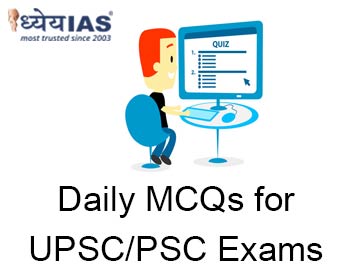Home > Daily-mcqs
Daily-mcqs 04 Jun 2025

Q1:
Which of the following countries share a direct border with Paraguay? 1. Brazil 2. Uruguay 3. Bolivia 4. Argentina Options:
A: 1 and 2 only
B: 1, 3 and 4 only
C: 2, 3 and 4 only
D: All four
Answer: B
Explanation:
Paraguay shares borders with Brazil, Argentina, and Bolivia. It does not border Uruguay, which is farther southeast, separated by Argentina.
Q2:
Which of the following statements are correct about the impact of industrial pollution on ocean ecosystems? 1. Human-generated iron from air pollution stimulates phytoplankton growth. 2. Increased phytoplankton growth slows down nutrient loss in surface waters. 3. Changes in iron levels are shifting ecosystem boundaries in the ocean. 4. Iron pollution in oceans cannot be traced back to its original sources. How many of the above statements are correct?
A: Only 1
B: Only 2
C: Only 3
D: All four
Answer: C
Explanation:
Statements 1 and 3 are correct as the study shows that human-made iron boosts phytoplankton and has shifted the transition zone chlorophyll front (TZCF) northward. Statement 2 is incorrect: increased phytoplankton activity accelerates nutrient depletion, especially nitrates. Statement 4 is also incorrect — the study used distinct isotopic signatures to trace industrial iron back to pollution sources.
Q3:
Which of the following statements about the SPMEPCI scheme is/are correct? 1. The scheme allows 100% customs duty exemption for electric four-wheelers below a certain value. 2. Manufacturers must meet a minimum 25% Domestic Value Addition (DVA) within 3 years to retain benefits. 3. The scheme permits both greenfield and brownfield investments, subject to specific conditions. Select the correct answer using the code below:
A: 1 and 2 only
B: 2 and 3 only
C: 1 and 3 only
D: All four
Answer: B
Explanation:
Statement 1 is incorrect while Statements 2 and 3 are correct: The Scheme to Promote Manufacturing of Electric Passenger Cars in India (SPMEPCI) scheme does not offer a 100% customs duty exemption for electric four-wheelers. Instead, it provides a reduced customs duty rate of 15% on Completely Built Units (CBUs) with a minimum Cost, Insurance, and Freight (CIF) value of $35,000, valid for five years. This is designed to attract high-value EV imports initially. The scheme mandates manufacturers to achieve at least 25% Domestic Value Addition (DVA) within three years to qualify for continued benefits. Additionally, both greenfield and brownfield investments are permitted, with brownfield projects required to be physically distinct from existing facilities to ensure genuine expansion.
Q4:
Consider the following statements about Bharat Gen, India’s indigenous AI-based Large Language Model (LLM): 1. Bharat Gen supports multimodal AI capabilities including text, speech, and images. 2. It is designed to support only Hindi and English languages. 3. Bharat Gen is developed under the National Mission on Interdisciplinary Cyber-Physical Systems (NM-ICPS). 4. The model is aimed at applications in healthcare, education, governance, and agriculture. Which of the statements given above are correct?
A: 1, 3 and 4 only
B: 2 and 3 only
C: Only 1 and 4
D: All of the above
Answer: A
Explanation:
Bharat Gen supports multimodal AI functions integrating text, speech, and image processing. It supports 22 Indian languages, not just Hindi and English, making statement 2 incorrect. It is developed under the NM-ICPS initiative by IIT Bombay with DST backing. The model aims to improve diverse sectors such as healthcare, education, governance, and agriculture by providing AI solutions tailored to India’s multilingual and multicultural context.
Q5:
The term ‘nominal GDP’ refers to:
A: GDP adjusted for inflation
B: GDP measured at current market prices without adjusting for inflation
C: GDP growth rate excluding government expenditure
D: GDP growth rate after subsidies and taxes
Answer: B
Explanation:
Nominal GDP is calculated at current market prices and includes the effects of inflation. It reflects the total value of goods and services produced in an economy before adjusting for price changes. Real GDP, in contrast, is inflation-adjusted.